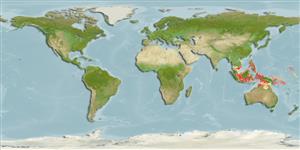>
Gobiiformes (Gobies) >
Microdesmidae (Wormfishes) > Ptereleotrinae
Etymology: Oxymetopon: Greek, oxys = sharp + Greek, metopon = brow (Ref. 45335).
Environment: milieu / climate zone / depth range / distribution range
Ekologi
marina revassocierade; djupintervall 10 - 45 m (Ref. 90102), usually 10 - 35 m (Ref. 27115). Tropical; 24°C - 27°C (Ref. 27115)
Western Pacific: Indonesia (Ref. 9710) and Philippines.
Size / Vikt / Age
Maturity: Lm ? range ? - ? cm
Max length : 20.0 cm TL hane/ej könsbestämd; (Ref. 9710)
Short description
Bestämningsnycklar | Morfologi | Morfometri
Taggstrålar i ryggfenan (totalt) : 6 - 7; Mjukstrålar i ryggfenan (totalt) : 31; Taggstrålar i analfenan: 1; Mjukstrålar i analfenan: 27.
Found on deep mud slopes (Ref. 9710, 48637). Lives in pairs in burrows (Ref. 9710).
Life cycle and mating behavior
Maturities | Reproduktion | Spawnings | Egg(s) | Fecundities | Larver
Masuda, H. and G.R. Allen, 1993. Meeresfische der Welt - Groß-Indopazifische Region. Tetra Verlag, Herrenteich, Melle. 528 p. (Ref. 9137)
IUCN Red List Status (Ref. 130435)
Threat to humans
Harmless
Human uses
Fiskeri: kommersiell; Akvarium: Kommersiell
Verktyg
Special reports
Download XML
Internet-källor
Estimates based on models
Preferred temperature (Ref.
123201): 28 - 29.1, mean 28.7 °C (based on 138 cells).
Phylogenetic diversity index (Ref.
82804): PD
50 = 0.5312 [Uniqueness, from 0.5 = low to 2.0 = high].
Bayesian length-weight: a=0.00389 (0.00180 - 0.00842), b=3.12 (2.94 - 3.30), in cm total length, based on all LWR estimates for this body shape (Ref.
93245).
Trofisk nivå (Ref.
69278): 3.5 ±0.5 se; based on size and trophs of closest relatives
Fishing Vulnerability (Ref.
59153): Low vulnerability (10 of 100).
